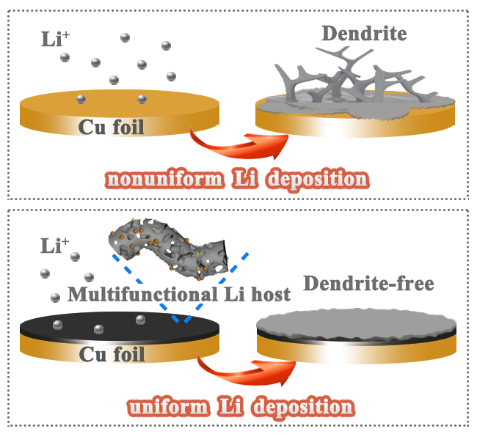Low Coulombic efficiency and safety issues are huge problems that hinder the practical application of Li metalanodes. Constructing Li host structures decorated with functional species can restrain the growth of Li dendrites and alleviate the great volume change. Here, a three-dimensional (3D) porous carbonaceous skeleton modified with rich lithiophilic groups (Zn, ZnO and Zn(CN)2) is synthesized as a Li host via one-step carbonization of a triazole-containing metal-organic framework. The nano lithiophilic groups serve as preferred sites for Li nucleation and growth, regulating a uniform Li+flux and uniform current density distribution. In addition, the 3D porous network functions as a Li reservoir that provides rich internal space to store Li, thus alleviating the volumetric expansion during Li plating/stripping process. Thanks to these component and structural merits,an ultra-low overpotential for Li deposition is achieved, together with high Coulombic efficiency of over 99.5% for more than 500 cycles at 1 mA cm-2and 1 mAh cm-2in half cells. The symmetric cells exhibit a prolonged cycling of 900 h at 1 mA cm-2. The full cells by coupling Zn/ZnO/Zn(CN)2@C-Li anode with LiFePO4cathode deliver a high capacity retention of 94.3 % after 200 cycles at 1 C. Moreover, based on the easy carbonization technologies, the Zn/ZnO/Zn(CN)2@C lithium anodes could be easily scaled up, greatly benefiting the development of future lithium batteries.
This work was supported by the National Natural Science Foundation of China, Shenzhen Science and Technology Program, etc.. The article is available from https://doi.org/10.1002/smll.202306187.

Figure 1. Schematic illustration of the 3D lithiophilic Li host for uniform Li deposition


